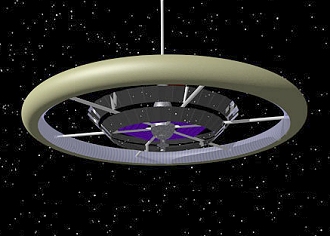|

In Star
Trek, the crew of a
starship is free to move about their ship without the problems of
weightlessness because of a network of small generators working
together to provide 'artificial' gravity. The gravity field
itself is created by a controlled stream of gravitons, using the same
principles as the Star Trek tractor beam. According to The Star Trek The Next Generation
Technical Manual, the gravity generators use
superconductor technology, where a superconducting stator of thoronium
arkenide is suspended in pressurized chrylon gas. In a memorable scene
from the movie Star Trek VI: The
Undiscovered Country, the Klingon ship Kronos One is hit by
photon torpedoes and its artificial gravity field fails. The whole ship
experienced weightlessness for several minutes while assassins boarded
and killed several members of the crew, including Chancellor
Gorkon.
|

Artificial gravity generator, as depicted in the The Star Trek: The Next Generation
Technical Manual
|
Living in zero-gravity environments for
extended periods of time can produce detrimental health effects on
humans, such as muscle atrophy and deterioration of the skeleton,
slowing of the cardiovascular system, decreased production of red blood
cells, balance disorders, and a weakening of the immune system. Many of
the conditions caused by exposure to weightlessness are similar to
those resulting from aging. To address this problem, modern-day
space research has focussed on the only substitute for gravity in a
zero-gravity environment - the force created by acceleration. The only
acceleration that can be sustained without continuous energy input is
centripetal acceleration - that is, rotation. A rotating
spacecraft will produce the feeling of gravity on its inside hull. This
centripetal force drives any object inside the spacecraft toward the
hull, thereby giving the appearance of a gravitational pull directed
outward. The Stanford torus space station design, for example, rotates
once per minute to provide between 0.9g and 1.0g of artificial gravity
on the inside of its outer ring via centripetal acceleration.

|

The Stanford Torus
|



